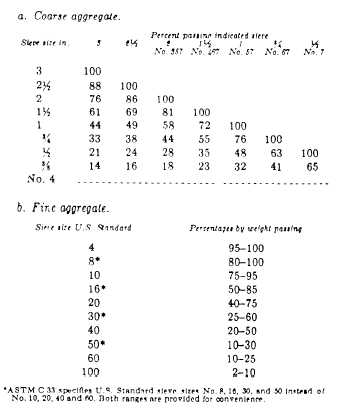economy of the mix. Too much fine aggregate, besides
preventing a good bonding, also increases the surface
area that must be coated with cement paste. That
weakens the concrete. Good gradation results in a dense
mass of concrete with a minimum volume of voids, an
economical mix, and a strong structure. Optimum
strength, watertightness, and durability in the hardened
concrete require careful control of aggregate gradation.
DURABILITY.— Durability is the ability to resist
the elements of weathering and the load pressures. Weak
or easily crushed rock or other mineral particles that
break down under the applied loads will cause changes
in the internal stresses and a breakdown of the concrete.
Rocks or mineral particles that are absorptive or
susceptible to swelling when saturated will disintegrate
when acted upon by different weather conditions.
Freezing moisture causes expansion stresses that can
easily rupture absorptive rocks. Radiant heat from the
sun causes rocks to swell. If the heat is then followed by
sudden cooling because of a shower and temperature
drop, shrinkage and a breakdown of some rocks
frequently occur. The aggregate must be chosen to
withstand these forces of nature.
DETERIORATION.— Deterioration of concrete,
in many cases, can be traced to the aggregate. An
excessive amount of organic material in or on the
aggregate prevents the cement paste from forming an
adequate bond with the aggregate particles. A large
percentage of clay or fine silts adhering to the aggregate
may prevent the cement paste from reaching the
particles. That results in a structurally weak concrete
that also is susceptible to breakdown by weathering.
Washing the aggregate to remove the silts, clays, and
organic material prevents this problem.
CHEMICAL COMPOSITION.— Chemical com-
position of the aggregate is also important. Any
chemical reaction between aggregate and cement in the
presence of water reduces the hardening and cementing
process. Any reduction in the amount of water-cement
paste caused by a chemical reaction reduces the amount
available to bond to the aggregate. This result is similar
to one caused by an insufficient amount of cement.
Tests for Aggregates
For aggregate tests to be worthwhile, the sample
secured for testing must be representative of the supply
of aggregates. If possible, samples should represent the
processed and ready-for-use aggregate. Sufficient
samples should be taken from the processing plant
discharge to represent the material in the stockpile. The
sample should contain at least four times as much
material as is needed for testing and should be reduced
to the size desired for testing by quartering. The standard
method for sampling aggregate can be found in ASTM
D 75.
Stockpile samples should be taken at or near the
base, at about the middle, and at the top of the pile. Three
or four such samples should be taken and recombined.
A board shoved into the pile just above the point of
sampling will prevent the material above the sampling
point from falling or sifting into the sample.
Unprocessed sources of sand and gravel should be
taken by channeling exposed faces, or they should be
taken from pits if exposures are not available. Take care
to ensure that the samples include only those materials
that are below the overburden or strip zone.
TESTS FOR GRADATION.— A sieve analysis
indicates whether an aggregate is coarse or fine and
whether it is evenly or unequally distributed between the
larger and smaller sizes. This information is useful in
deciding whether the aggregate will make good
concrete. Analysis methods can be found in ASTM C
136. Table 13-2 shows the acceptable gradation limits.
Table 13-2.—Desirable Gradation for Aggregates in Concrete
13-22



